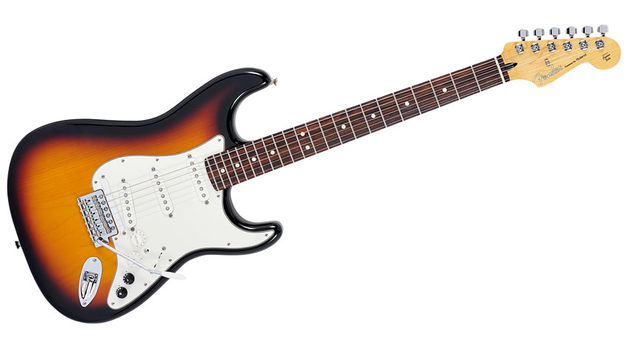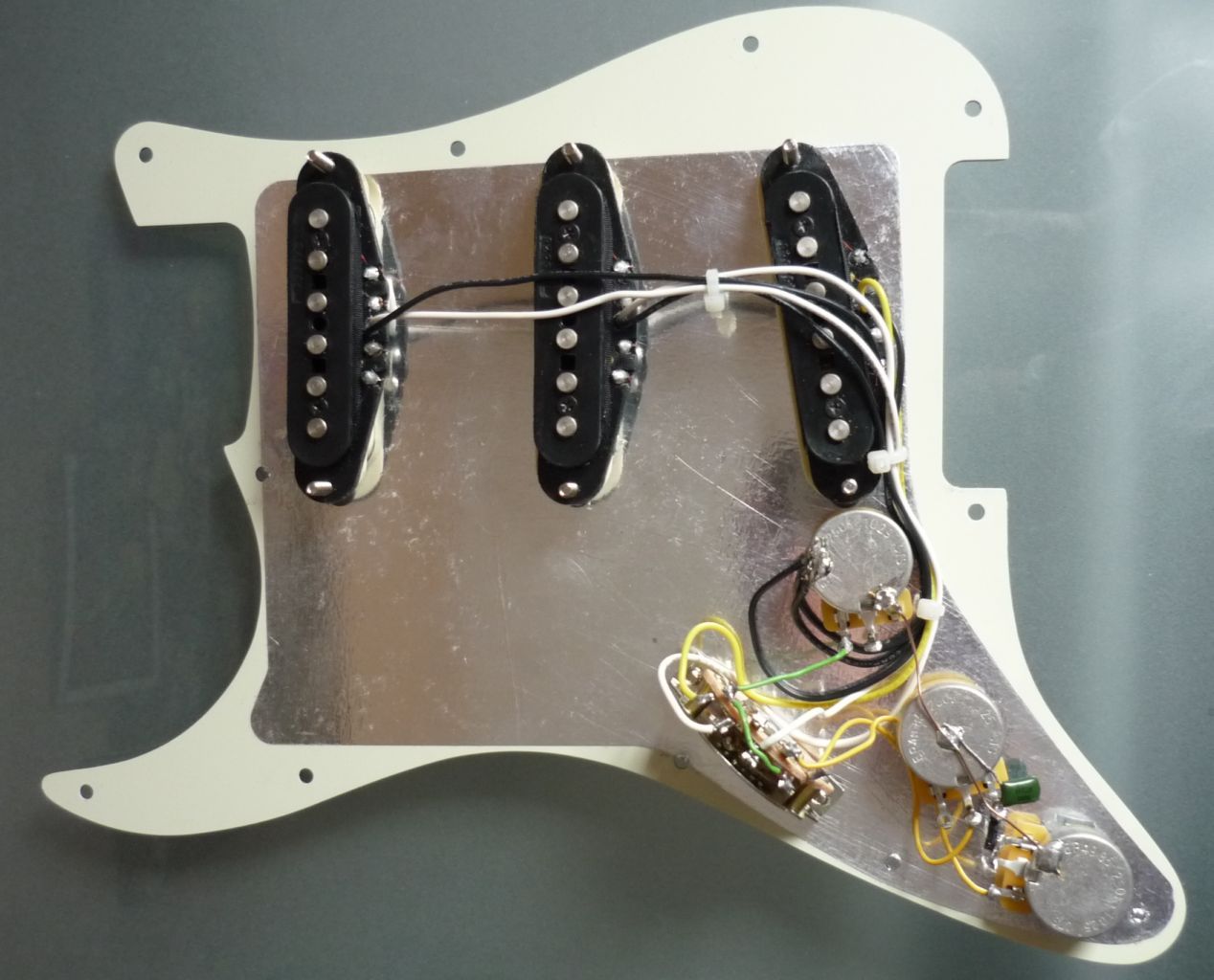2014 was the sixtieth anniversary of the Fender Stratocaster.
You may not know guitars – but you’ve heard them.

NPR did a pretty decent story on the the anniversary, and the guitar, last week. Leo Fender designed the “Strat” as the followup to the much-more-conventional but also legendary Telecaster.

A “Telly”
The thing that jumps out at the non-guitar player is the body shape – a radical double-cutaway design (allowing the guitarist to easily get to the highest notes on the neck).
For the musician, there was the vibrato bar – the “whammy bar” – at the bridge, immortalized by a generation of surf-rockers and, in a much-modified form, Eddie Van Halen:

The “whammy bar”, up close
And for guitarists who really, really dig into it? The “Strat” was an incredibly versatile instrument.

The Strat’s pickups, switch, “pots” (volume and tone knobs) and wiring, from the inside.
Its three “pickups” – the three little oval bars, basically microphones that turn the vibration of the strings into electrical signals that are sent to the amplifier – are connected to a five position switch that allows the guitarist to select which of the three pickups, or which combination, are live. The one closest to the bridge picks up more treble, and is most useful for playing solos; the one closest to the fingerboard is usually lower and bassier, and is usually used for playing rhythm. The one in the middle is…well, in the middle.
The cool part is that the “in between” positions, 2 and 4 respectively, the signals from the fingerboard or bridge pickups are out of phase with the middle pickup. It gives you a funky, reedy tone that is hard to describe, but impossible to miss (think “Sultans of Swing” by Dire Straits, or “Smoking Gun” by Robert Cray, or “The Core” by Eric Clapton).
The Strat has been the instrument of choice for an army of guitarists, all over the spectrum; from bluesmen like Eric Clapton (who has been pretty exclusively identified with Strats for the past forty years) and Robert Cray, through rockers like Jimi Hendrix, to peripatatic fretboard stylists like Mark Knopfer and Richard Thompson, to jazz and big band players, the Strat has been there and done that.
And it almost didn’t turn out that way. The Strat’s first couple of years of sales were disappointing; Leo Fender fielded criticisms of the Strat’s bright, sharp sound, causing him to design a followup, the “Jazzmaster”:

A Jazzmaster – most easily identified with Elvis Costello, J Mascis, Sonic Youth’s Lee Ranaldo, Mick Jagger (during his brief, late-seventies flirtation with playing guitar) and…yours truly, whose primary axe has been a Jazz for, um, 36 years. Mine is heavily modified, by the way – I have a third, Gibson “Soap Bar” pickup between the two stock pickups, wired out of phase, like a Strat – which actually gives a version of the Strat’s signature sound. It’s complicated – but sounds pretty awesome. But I digress.
The “Jazz” was designed to address the Strat’s “shortcomings”; the pickups were wired for a thicker, warmer sound, with more muted trebles and fuller bass and midranges. It was a more conservative design, both aesthetically and electrically.
But in the interim, rock and roll happened. And the Strat – a relative bargain at the time – became, sharp tone and all, the preferred instrument of a generation of rock and rollers.
So successful was the Strat, of course, that the Gibson company – which had been producing the iconic, heavier, more-expensive “Les Paul”, reacted by producing a “Les Paul Junior”, with a lighter double-cutaway body; it’s better known today as the “SG”:

SG, Les Paul and Strat. I’ll take one of each, thanks.
And, notwithstanding a brief flash of Beatles-driven popularity for Rickenbacker guitars (brought back by Tom Petty in the late seventies), that’s been pretty much bedrock of the rock and roll guitarist’s arsenal ever since.
I’ve never owned a Strat – yet. Someday.

“SG, Les Paul and Strat. I’ll take one of each, thanks.”
Plus the modern Les Paul Jr. (Billy Joe from Green Day, Johnny Ramone, and Joan Jett)
I have a strat ,so this is a bit pedantic, but hey, we’re musicians, so I have to point out that in the whammy bar pic the strat features a humbucker.
Something I am thinking of doing to my strat. I have already replaced a pickup in it. (Dimarzio)
Did you do the work on your Jazz?
I don’t know MBerg, you seem like an empty nester, a fellow with time on his hands. Maybe you go Heathkit/Hobby Lobby/Home Depot on the bit and build your self one of these…
http://www.rollingstone.com/music/pictures/20-iconic-guitars-20120523/bo-diddleys-cigar-box-0156710
… I always liked that sound. And considering all that was ‘stolen’ from Mr. Diddley through the years, so must have others.
I was blessed by my wonderful wife with a new 2004 (50th anniversary) Strat for my birthday that year. Although it’s just an American Standard, not a special commemorative model, it, like all Strats made that year, is marked on the neck plate with a 50th anniversary logo. Of course, it’s a Sunburst with Maple neck. She also bought me the same-configured Telecaster for our 20 year wedding anniversary.
Mr. Berg (and other guitar aficionados): You must read the book, “17 Watts?” by Mo Foster. (ISBN: 1-86074-267-X), if you haven’t read it already:
https://clintspoon.wordpress.com/2012/02/29/17-watts-the-birth-of-british-rock-guitar-mo-foster/
It’s pretty much about how the blues and rock and roll music in late-40s – early-50’s Britain created a huge demand for electric guitars and amps. It also details how the need was creatively fulfilled until post-WWII European trade restrictions were lifted and American instruments were then allowed to be imported. Lots of early blues, rock and roll, and rock music greats are interviewed. Their early instruments are also detailed.
Truly a must-read for any guitar lover. Unfortunately, it’s out-of-print and extremely expensive to purchase. I treasure my copy which I bought several years ago in a Half Price Books clearance section for a couple bucks. He wrote another book, “Play Like Elvis” which is alleged to be the same book. I have a copy on order and will know shortly if it’s a true reissue. YOU MUST READ THIS IF YOU CAN.
It’s a bit geeky, but well worth the effort, if for nothing else, it’s vast collection of music industry and guitar trivia.
As luck would have it, my copy of “Play Like Elvis” arrived today. It is a duplication of “17 Watts?”, apparently title-changed for the American market.
The “17 Watts?” books are fairly pricey:
http://www.amazon.com/s/ref=nb_sb_noss?url=search-alias%3Dstripbooks&field-keywords=17+watts+mo+foster
My “Elvis” version was about $7with shipping and handling. Again, I strongly recommend it, and it is readily available on Amazon.
By the way, the title, “17 Watts?” comes from a comment make by the author as a teen to his young band mates. The five of them decided to pool their money and make a group purchase of a Watkins Dominator amp.
It had four inputs so they could all use it at once. While discussing the purchase, Foster asked the group, “Do we really need 17 watts?.” Up to that point, they’d been playing through tape recorders, phonographs, and other small amplification devices, and they thought 17 watts might be excessive.
Anyway, worth a shot on a cold night …